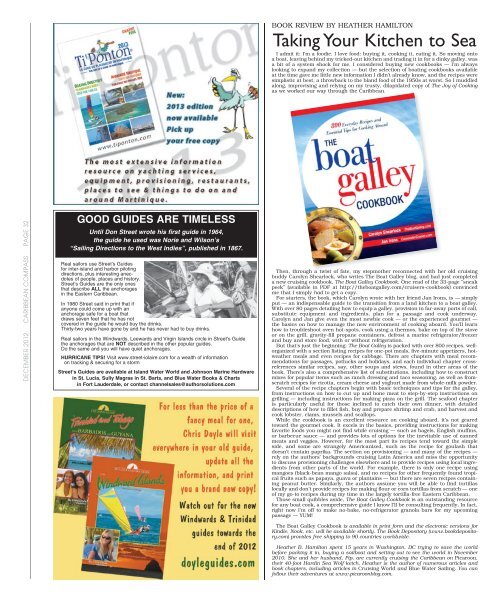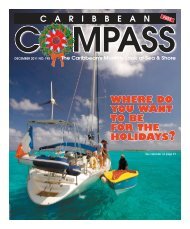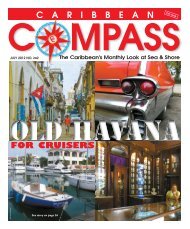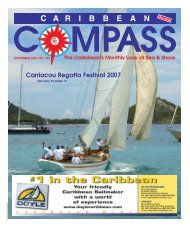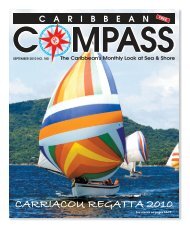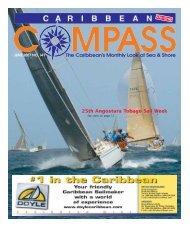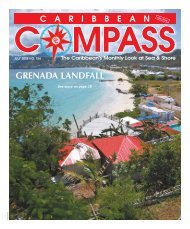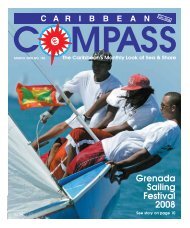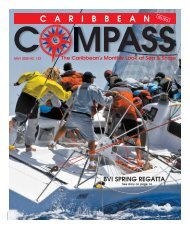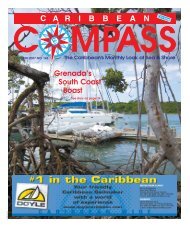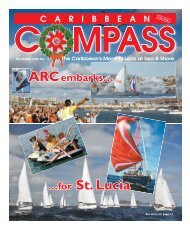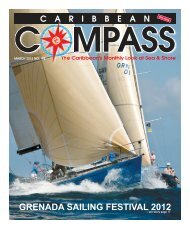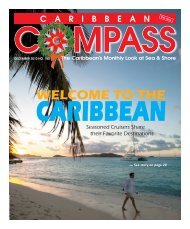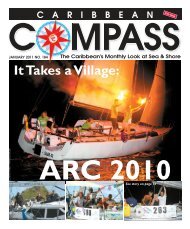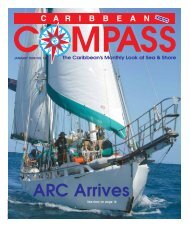Subscribers - Click here - Caribbean Compass
Subscribers - Click here - Caribbean Compass
Subscribers - Click here - Caribbean Compass
You also want an ePaper? Increase the reach of your titles
YUMPU automatically turns print PDFs into web optimized ePapers that Google loves.
DECEMBER 2012 CARIBBEAN COMPASS PAGE 32<br />
GOOD GUIDES ARE TIMELESS<br />
Until Don Street wrote his first guide in 1964,<br />
the guide he used was Norie and Wilson’s<br />
“Sailing Directions to the West Indies”, published in 1867.<br />
Real sailors use Street’s Guides<br />
for inter-island and harbor piloting<br />
directions, plus interesting anecdotes<br />
of people, places and history.<br />
Street’s Guides are the only ones<br />
that describe ALL the anchorages<br />
in the Eastern <strong>Caribbean</strong>.<br />
In 1980 Street said in print that if<br />
anyone could come up with an<br />
anchorage safe for a boat that<br />
draws seven feet that he has not<br />
covered in the guide he would buy the drinks.<br />
Thirty-two years have gone by and he has never had to buy drinks.<br />
Real sailors in the Windwards, Leewards and Virgin Islands circle in Street’s Guide<br />
the anchorages that are NOT described in the other popular guides.<br />
Do the same and you will have quiet anchorages.<br />
HURRICANE TIPS! Visit www.street-iolaire.com for a wealth of information<br />
on tracking & securing for a storm<br />
Street’s Guides are available at Island Water World and Johnson Marine Hardware<br />
in St. Lucia, Sully Magras in St. Barts, and Blue Water Books & Charts<br />
in Fort Lauderdale, or contact channelsales@authorsolutions.com<br />
BOOK REVIEW BY HEATHER HAMILTON<br />
Taking Your Kitchen to Sea<br />
I admit it: I’m a foodie. I love food: buying it, cooking it, eating it. So moving onto<br />
a boat, leaving behind my tricked-out kitchen and trading it in for a dinky galley, was<br />
a bit of a system shock for me. I considered buying new cookbooks — I’m always<br />
looking to expand my collection — but the selection of boating cookbooks available<br />
at the time gave me little new information I didn’t already know, and the recipes were<br />
simplistic at best, a throwback to the bland food of the 1950s at worst. So I muddled<br />
along, improvising and relying on my trusty, dilapidated copy of The Joy of Cooking<br />
as we worked our way through the <strong>Caribbean</strong>.<br />
Then, through a twist of fate fate, my stepmother reconnected with he<br />
her old cruising<br />
buddy Carolyn Shearlock, who writes The Boat Galley blog, and had just completed<br />
a new cruising cookbook, The Boat Galley Cookbook. One read of the 33-page “sneak<br />
peek” (available in PDF at http://theboatgalley.com/cruisers-cookbook) convinced<br />
me that I simply had to get a copy.<br />
For starters, the book, which Carolyn wrote with her friend Jan Irons, is — simply<br />
put — an indispensable guide to the transition from a land kitchen to a boat galley.<br />
With over 80 pages detailing how to equip a galley, provision in far-away ports of call,<br />
substitute equipment and ingredients, plan for a passage and cook underway,<br />
Carolyn and Jan give even the most newbie cook — or the experienced gourmet —<br />
the basics on how to manage the new environment of cooking aboard. You’ll learn<br />
how to troubleshoot oven hot-spots, cook using a thermos, bake on top of the stove<br />
or on the grill, gravity-fill propane containers, defrost a marine refrigerator/freezer<br />
and buy and store food, with or without refrigeration.<br />
But that’s just the beginning: The Boat Galley is packed with over 800 recipes, wellorganized<br />
with a section listing recipes for one-pot meals, five-minute appetizers, hotweather<br />
meals and even recipes for cabbage. T<strong>here</strong> are chapters with meal recommendations<br />
for passages, potlucks and holidays, and each individual chapter crossreferences<br />
similar recipes, say, other soups and stews, found in other areas of the<br />
book. T<strong>here</strong>’s also a comprehensive list of substitutions, including how to construct<br />
mixes for popular items such as ranch dressing and taco seasoning, as well as fromscratch<br />
recipes for ricotta, cream cheese and yoghurt made from whole-milk powder.<br />
Several of the recipe chapters begin with basic techniques and tips for the galley,<br />
from instructions on how to cut up and bone meat to step-by-step instructions on<br />
grilling — including instructions for making pizza on the grill. The seafood chapter<br />
is particularly useful for those inclined to catch their own dinner, with detailed<br />
descriptions of how to fillet fish, buy and prepare shrimp and crab, and harvest and<br />
cook lobster, clams, mussels and scallops.<br />
While the cookbook is an excellent resource on cooking aboard, it’s not geared<br />
toward the gourmet cook. It excels in the basics, providing instructions for making<br />
favorite foods you might not find while cruising — such as bagels, English muffins,<br />
or barbecue sauce — and provides lots of options for the inevitable use of canned<br />
meats and veggies. However, for the most part its recipes tend toward the simple<br />
side, and some are strangely Americanized, such as the recipe for goulash that<br />
doesn’t contain paprika. The section on provisioning — and many of the recipes —<br />
rely on the authors’ backgrounds cruising Latin America and miss the opportunity<br />
to discuss provisioning challenges elsew<strong>here</strong> and to provide recipes using local ingredients<br />
from other parts of the world. For example, t<strong>here</strong> is only one recipe using<br />
mangoes (black-bean mango salsa), and no recipes for other frequently found tropical<br />
fruits such as papaya, guava or plantains — but t<strong>here</strong> are seven recipes containing<br />
peanut butter. Similarly, the authors assume you will be able to find tortillas<br />
locally and don’t provide recipes for making flour or corn tortillas from scratch — one<br />
of my go-to recipes during my time in the largely tortilla-free Eastern <strong>Caribbean</strong>.<br />
Those small quibbles aside, The Boat Galley Cookbook is an outstanding resource<br />
for any boat cook, a comprehensive guide I know I’ll be consulting frequently. In fact,<br />
right now I’m off to make no-bake, no-refrigerator granola bars for my upcoming<br />
passage — YUM!<br />
The Boat Galley Cookbook is available in print form and the electronic versions for<br />
Kindle, Nook, etc. will be available shortly. The Book Depository (www.bookdepository.com)<br />
provides free shipping to 90 countries worldwide.<br />
Heather B. Hamilton spent 15 years in Washington, DC trying to save the world<br />
before packing it in, buying a sailboat and setting out to see the world in November<br />
2010. She and her husband, Pip, are currently cruising the <strong>Caribbean</strong> on Picaroon,<br />
their 40-foot Hardin Sea Wolf ketch. Heather is the author of numerous articles and<br />
book chapters, including articles in Cruising World and Blue Water Sailing. You can<br />
follow their adventures at www.picaroonblog.com.


